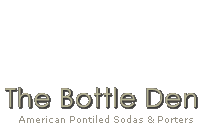Featured Article: Baltimore's "Specialty Ale" Form
Article VI - New Ale Form Emerges | back to Articles
by Wil Martindale
Nearly a year ago, site visitors may recall the Mobile Show Report in which I described a deep cherry puce cylinder acquired at the show. Back then I had attributed the piece to the Baltimore Glassworks, based primarily on it's color and pontil characteristics, and I have since compared the rounded lower bevel of the lip treatment to several marked Baltimore porters and have found them to be nearly identical as well. Chris Rowell later confirmed having dug an identical example in Baltimore.
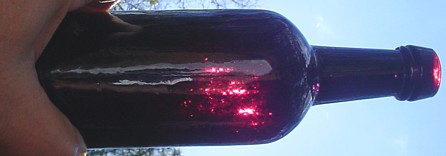
I made the statement back then to several fellow collectors that I felt the bottle was an ale or porter based on several clues. First of all, the bottle is very heavy and thick-walled (typical of sodas and beers), made to withstand frequent re-use, washings with scalding water, and pressure from carbonation build-up during fermentation. Second was the porter style lip--odd on a non-porter form, but in keeping with the thick-walled construction. And third was the bail wire wear around the neck, typical of wear from the wire used to secure the cork from popping as carbonation builds.
This bottle simply did not seem to me to be a sauce or "utility" in the general sense of the term, so I had formed the opinion early on that this was some sort of unusual ale form, probably designed to differentiate a seasonal brew or specialty ale from the typical lager and porter forms already established in Baltimore and the surrounding regions.
Like the 5 dot mold porter, I was destined to uncover some very convincing evidence to substantiate that opinion--except that this time it wouldn't take 30 years to surface.
Around the same time that I acquired this puce cylinder, I became aware of a Brummel & Byrne cylinder which had an undeniable Baltimore style porter top. But the images I viewed of the bottle did not reveal its proportions, and I mistook it for a modified whiskey fifth. Knowing that Brummel & Byrne were bottlers in Richmond who used a porter with a Baltimore style top, I surmised that they may have also bottled whiskey. I was mildly interested in the bottle as a rare product of the Baltimore Glassworks, but not being a whiskey collector, not really impassioned to acquire it.
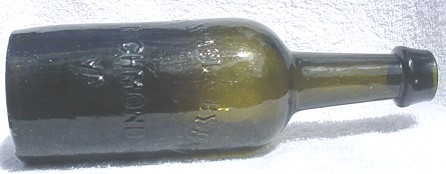
As there are known examples of larger mineral waters in that form, and as Brummel and Byrne also bottled mineral and soda waters, I eventually listed the bottle as a mineral fifth in the APS database. But this was enigmatic at best, since the mineral 5th is a much later (1870's) form, and Brummel and Byrne had no evidential history of having delved into the whiskey bottling trade. Needless to say, I had not yet made the connection to the puce cylinder, which I considered a unique oddity -- it never entered my mind that those two bottles could possibly be only an eighth of an inch apart in height when I added the listing.
Then, on a rare occasion that this website actually attracts an equally rare bottle owner to me, it was this listing that prompted the owner to contact me and send some pics of the bottle next to a common spray can. We took exact measurements and I found that the form of the Brummel was nearly identical to that of my deep cherry puce example. And with the undeniable Baltimore taper top, that pretty much "sealed the deal" on provenance for both bottles (as well as the known squat porter form).
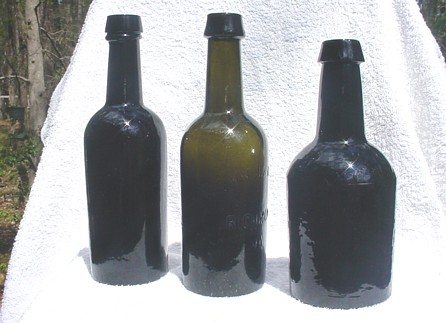
I managed to acquire the bottle in Chester, Va. on the way to Maryland, the day before the Baltimore show. There at the show, Jim Hagenbuch, upon viewing it, mentioned handling a rare New Jersey bottle in a similar form. Later, Tod von Mechow described a Reynolds (the prolific Philadelphia bottler) with a similar form, and his research indicated that it contained a "London Porter".
With those confirmations, I am satisfied with the idea that a unique, slender form was in use during the iron pontil era which would have been used for a more exclusive brew, such as an imported ale or porter, or a limited run seasonal brew, or some other specialty ale of a distinctive caliber.
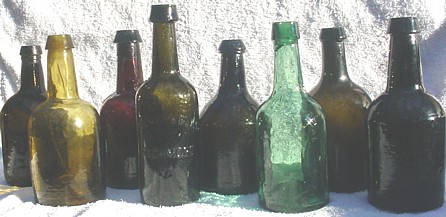
That might also account for the relative rarity of the form, as Chris Vaught could not recollect ever having dug even one of the blanks in all his years of emptying Baltimore privies, and none of the Richmond people we talked to appeared to be aware of this form, or this bottle's existance.
This bottle exhibits the same tall, narrow seraphed font which is employed in the rare W.H. Buck and C Clark slug plate molds which are typical of a blank slug plate form often dug in Baltimore. The embossing style is unusual for Baltimore, and this plate mold engraver appears to have been used almost exclusively for bottles ordered by the Southern market (Richmond, Norfolk, Charleston, etc.).
While up north, we also confirmed a blank slug plate mold dug in Baltimore which matches the rare "B. H. JINK" and "B. H. FINK" Charleston sodas with the exact same "TO BE / RETURNED" reverse embossing.
Naturally, I am interested in acquiring more of these pontiled specialty ales, as they represent important pieces of the puzzle that forms the overall picture of America's soda and beer bottling industry during the pontil era.
